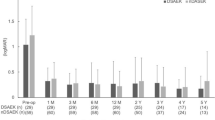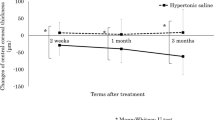Abstract
Purpose
This study evaluated the safety and efficacy of Bowman’s membrane electrocautery in blind painful eyes with bullous keratopathy not amenable to corneal transplantation.
Methods
Eleven eyes of 11 subjects with painful bullous keratopathy and poor visual potential who underwent electrocautery of Bowman’s membrane at a tertiary referral ophthalmology clinic were reviewed retrospectively. Subject demographics and preoperative and postoperative data were collected, including description of pain, slit lamp biomicroscopy, best corrected visual acuity, topical medication use, and complications. Efficacy of the procedure on pain reduction, bullae resolution, and topical medication use were assessed at post-operative visits. Safety was also evaluated based on any complications.
Results
Bowman’s membrane electrocautery effectively resolved bullae in all eyes examined up to 6 months postoperatively; however, 2 eyes had recurrence by 1 year. Mean age at the time of surgery was 69.8 years and mean duration of follow-up was 15.4 months. Pain reduction was achieved in all eyes at 1 month, but 1 subject had pain recurrence by 6 months and another by 1 year. The median number of drops per day decreased from 6 preoperatively to 1.7 at 6 months. Two subjects who had underlying advanced ophthalmic disease had a mild reduction in vision.
Conclusion
Bowman’s membrane electrocautery is a safe and minimally invasive procedure for the management of painful bullous keratopathy in eyes with low vision potential and not amenable to corneal transplantation. Duration of effect appears to last at least 6 months and up to 3 years post-procedure.



Similar content being viewed by others
Code availability
Not applicable.
References
Zemba M (2006) Palliative treatment in bullous keratopathy. Oftalmologia 50:23–26
Siu GDJ-Y, Young AL, Jhanji V (2014) Alternatives to corneal transplantation for the management of bullous keratopathy. Curr Opin Ophthalmol 25:347–352. https://doi.org/10.1097/ICU.0000000000000062
Salleras A (1965) Bullous keratopathy. Cornea world congr. Butterworth & Co, Washington, pp 292–299
Dantas P, Nishiwaki-Dantas M, Suzuki C et al (1998) Electrocautery of Bowman’s membrane for bullous keratopathy. Arq Bras Oftalmol. https://doi.org/10.5935/0004-2749.19980102
Thomann U, Meier-Gibbons F, Schipper I (1995) Phototherapeutic keratectomy for bullous keratopathy. Br J Ophthalmol 79:335–338. https://doi.org/10.1136/bjo.79.4.335
Thomann U, Niesen U, Schipper I (1996) Successful phototherapeutic keratectomy for recurrent erosions in bullous keratopathy. J Refract Surg 12:S290–S292
Chen J, Lan J, Liu D et al (2017) Ascorbic acid promotes the stemness of corneal epithelial stem/progenitor cells and accelerates epithelial wound healing in the cornea. Stem Cells Transl Med 6:1356–1365. https://doi.org/10.1002/sctm.16-0441
Maini R, Sullivan L, Snibson GR et al (2001) A comparison of different depth ablations in the treatment of painful bullous keratopathy with phototherapeutic keratectomy. Br J Ophthalmol 85:912–915. https://doi.org/10.1136/bjo.85.8.912
Gundersen T, Pearlson HR (1969) Conjunctival flaps for corneal disease: their usefulness and complications. Trans Am Ophthalmol Soc 67:78–95
Güell JL, Morral M, Gris O et al (2012) Treatment of symptomatic bullous keratopathy with poor visual prognosis using a modified Gundersen conjunctival flap and amniotic membrane ophthalmic surgery, lasers imaging. Off J Int Soc Imaging Eye 43:508–512. https://doi.org/10.3928/15428877-20120830-01
Koenig SB (1996) Annular keratotomy for the treatment of painful bullous keratopathy. Am J Ophthalmol 121:93–94. https://doi.org/10.1016/s0002-9394(14)70540-9
Georgiadis NS, Ziakas NG, Boboridis KG et al (2008) Cryopreserved amniotic membrane transplantation for the management of symptomatic bullous keratopathy. Clin Experiment Ophthalmol 36:130–135. https://doi.org/10.1111/j.1442-9071.2008.01696.x
Srinivas S, Mavrikakis E, Jenkins C (2007) Amniotic membrane transplantation for painful bullous keratopathy. Eur J Ophthalmol 17:7–10. https://doi.org/10.1177/112067210701700102
Espana EM, Grueterich M, Sandoval H et al (2003) Amniotic membrane transplantation for bullous keratopathy in eyes with poor visual potential. J Cataract Refract Surg 29:279–284. https://doi.org/10.1016/s0886-3350(02)01525-0
Pires RT, Tseng SC, Prabhasawat P et al (1999) Amniotic membrane transplantation for symptomatic bullous keratopathy. Arch Ophthalmol (Chicago, Ill 1960) 117:1291–1297. https://doi.org/10.1001/archopht.117.10.1291
Mejía LF, Santamaría JP, Acosta C (2002) Symptomatic management of postoperative bullous keratopathy with nonpreserved human amniotic membrane. Cornea 21:342–345. https://doi.org/10.1097/00003226-200205000-00002
Sridhar MS, Vemuganti GK, Bansal AK, Rao GN (2001) Anterior stromal puncture in bullous keratopathy: a clinicopathologic study. Cornea 20:573–579. https://doi.org/10.1097/00003226-200108000-00004
Hsu JK, Rubinfeld RS, Barry P, Jester JV (1993) Anterior stromal puncture. Immunohistochemical studies in human corneas. Arch Ophthalmol (Chicago, Ill 1960) 111:1057–1063. https://doi.org/10.1001/archopht.1993.01090080053018
Gomes JA, Haraguchi DK, Zambrano DU et al (2001) Anterior stromal puncture in the treatment of bullous keratopathy: six-month follow-up. Cornea 20:570–572. https://doi.org/10.1097/00003226-200108000-00003
Arora R, Manudhane A, Saran RK et al (2013) Role of corneal collagen cross-linking in pseudophakic bullous keratopathy: a clinicopathological study. Ophthalmology 120:2413–2418. https://doi.org/10.1016/j.ophtha.2013.07.038
Sharma N, Roy S, Maharana PK et al (2014) Outcomes of corneal collagen crosslinking in pseudophakic bullous keratopathy. Cornea 33:243–246. https://doi.org/10.1097/ICO.0000000000000004
Okumura N, Ueno M, Koizumi N et al (2009) Enhancement on primate corneal endothelial cell survival in vitro by a ROCK inhibitor. Invest Ophthalmol Vis Sci 50:3680–3687. https://doi.org/10.1167/iovs.08-2634
Okumura N, Koizumi N, Ueno M et al (2011) Enhancement of corneal endothelium wound healing by Rho-associated kinase (ROCK) inhibitor eye drops. Br J Ophthalmol 95:1006–1009. https://doi.org/10.1136/bjo.2010.194571
Funding
This study was supported by an unrestricted grant to the Department of Ophthalmology from Research to Prevent Blindness, New York, NY.
Author information
Authors and Affiliations
Contributions
Annie Nguyen and Martin Heur made substantial contribution to the conception or design of the work; all authors contributed to the acquisition, analysis, and interpretation of data; Kristina Voss and Cindi Kao Yim drafted the work, and all authors critically revised the work; all authors approved the version to be published; all authors agree to be accountable for the integrity and accuracy of the work.
Corresponding author
Ethics declarations
Ethics approval
This study was approved by the Institutional Review Board of the University of Southern California and adhered to the tenets of the Declaration of Helsinki.
Consent to participate
All patients underwent informed consent prior to receiving the intervention described.
Consent for publication
Patients signed informed consent regarding publishing their data and photographs.
Conflict of interest
The authors declare no competing interests.
Additional information
Publisher's Note
Springer Nature remains neutral with regard to jurisdictional claims in published maps and institutional affiliations.
Rights and permissions
About this article
Cite this article
Voss, K., Yim, C.K., Nguyen, A. et al. Use of Bowman’s membrane electrocautery in blind eyes with painful bullous keratopathy not amenable to corneal transplantation: a retrospective case series. Graefes Arch Clin Exp Ophthalmol 260, 191–196 (2022). https://doi.org/10.1007/s00417-021-05360-4
Received:
Revised:
Accepted:
Published:
Issue Date:
DOI: https://doi.org/10.1007/s00417-021-05360-4




